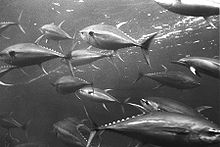
Back Scombridae Afrikaans إسقمريات Arabic اسقمريات ARZ Scombridae AST Skumbriyalar Azerbaijani Скумриеви Bulgarian Escòmbrids Catalan Tikab CEB Makrelovití Czech Makrelen und Thunfische German
| Scombridae Temporal range:
| |
|---|---|

| |
| Yellowfin tuna, Thunnus albacares | |
| Scientific classification | |
| Domain: | Eukaryota |
| Kingdom: | Animalia |
| Phylum: | Chordata |
| Class: | Actinopterygii |
| Order: | Scombriformes |
| Suborder: | Scombroidei |
| Family: | Scombridae Rafinesque, 1815 |
| Subfamilies | |
The mackerel, tuna, and bonito family, Scombridae, includes many of the most important and familiar food fishes. The family consists of 51 species in 15 genera and two subfamilies. All species are in the subfamily Scombrinae, except the butterfly kingfish, which is the sole member of subfamily Gasterochismatinae.[1]
Scombrids have two dorsal fins and a series of finlets behind the rear dorsal fin and anal fin. The caudal fin is strongly divided and rigid, with a slender, ridged base. The first (spiny) dorsal fin and the pelvic fins are normally retracted into body grooves. Species lengths vary from the 20 cm (7.9 in) of the island mackerel to the 4.58 m (15.0 ft) recorded for the immense Atlantic bluefin tuna.
Scombrids are generally predators of the open ocean, and are found worldwide in tropical and temperate waters. They are capable of considerable speed, due to a highly streamlined body and retractable fins. Some members of the family, in particular the tunas, are notable for being partially endothermic (warm-blooded), a feature that also helps them to maintain high speed and activity. Other adaptations include a large amount of red muscle, allowing them to maintain activity over long periods. Scombrids like the yellowfin tuna can reach speeds of 22 km/h (14 mph).[2]
- ^ Orrell, T.M.; Collette, B.B; Johnson, G.D. (2006). "Molecular data support separate Scombroid and Xiphioid Clades" (PDF). Bulletin of Marine Science. 79 (3): 505–519. Retrieved 28 October 2012.[permanent dead link]
- ^ Svendsen, Morten B. S.; Domenici, Paolo; Marras, Stefano; Krause, Jens; Boswell, Kevin M.; Rodriguez-Pinto, Ivan; Wilson, Alexander D. M.; Kurvers, Ralf H. J. M.; Viblanc, Paul E.; Finger, Jean S.; Steffensen, John F. (2016-10-15). "Maximum swimming speeds of sailfish and three other large marine predatory fish species based on muscle contraction time and stride length: a myth revisited". Biology Open. 5 (10): 1415–1419. doi:10.1242/bio.019919. ISSN 2046-6390. PMC 5087677. PMID 27543056.